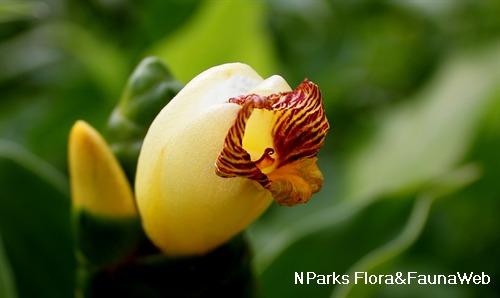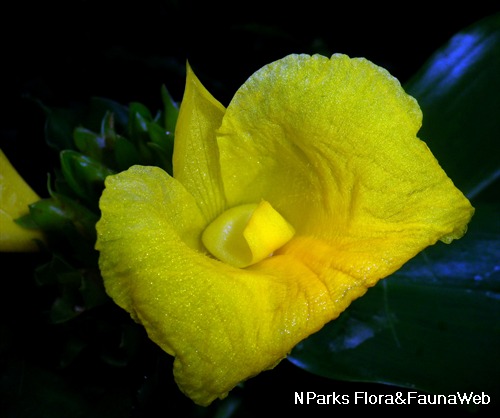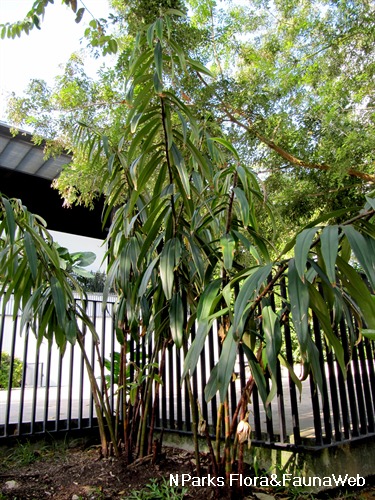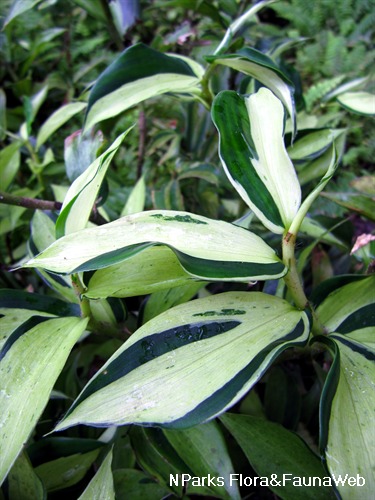.jpg)
Back
Costus productus variety
| Family Name: | Costaceae |
| Common Name: | Orange Tulip Ginger, Dwarf Orange Ginger, Green Mountain Spiral Flag |
The Orange Tulip Ginger was first erroneously sold in the horticulture trade as Costus curvibracteatus. It was only later identified as a variety of C. productus. It produces spirally-arranged leaves that resemble a spiral staircase, and orange flowers and bracts.
Name
Classifications and Characteristics
| Plant Division | Angiosperms (Flowering Seed Plants) (Monocotyledon) |
|---|---|
| Plant Growth Form | Herbaceous Plant |
| Lifespan (in Singapore) | Perennial |
| Mode of Nutrition | Autotrophic |
| Maximum Height | 0.6 m to 0.9 m |
Biogeography
| Native Distribution | Peru |
|---|---|
| Native Habitat | Terrestrial |
| Preferred Climate Zone | Tropical |
| Local Conservation Status | Non-native (Horticultural / Cultivated Only) |
Description and Ethnobotany
| Growth Form | It is a herbaceous, rhizomatous plant that grows up to 0.9 m tall with clumping habit. |
|---|---|
| Foliage | Leaves are light green, elliptic to obovate, up to 15 cm long and 6 cm wide, covered in soft hair, and with a sunken midrib. Leaves are arranged spirally along the shoot, resembling a spiral staircase. Leaf bases have a closed sheath with a minuscule ligule (projection at the top of the leaf sheath). |
| Stems | It has an underground rhizome (thick, horizontal modified stems) that produces green aboveground stems at regular intervals. |
| Flowers | Its inflorescence resembles a pine cone, up to 10 cm tall but usually much shorter at only 5-8 cm tall. Bracts are red-orange or bright orange. Flowers are tubular, up to 5 cm long, orange or yellowish-orange with red tips. |
| Fruit | Its fruit is a woody, ovoid capsule (a type of dry, dehiscent fruit). |
| Similar | This variety has some resemblance to Costus productus var. productus; however, it differs in having a shorter inflorescence, and orange flowers and bracts, as compared to Costus productus var. productus, which has longer inflorescence, bright red bracts, and bright yellow flowers. Unlike the Costus productus var. productus that has large oval/oblong ligules that overlap the leaf sheath, this variety has smaller two-lobed ligules. |
| Associated Fauna | The flowers are occasionally visited by sunbirds. |
| Taxonomy | This species/variety was initially mistaken for and sold under the identity of Costus curvibracteatus. It was subsequently sold as Costus productus var. productus but this was also an incorrect ID. It is now identified as one of the varieties under the Costus productus species complex. |
| Cultivation | It grows well in fertile, well-draining soil and semi-shaded conditions. Avoid exposing in the hot afternoon sun. If the soil is kept too moist, leaves may develop fungal spots. It can be propagated by division and rhizomes. |
| Ethnobotanical Uses | Edible Plant Parts : Edible Flowers Others: The edible flowers are sweet, occasionally with a sour tang. |
Landscaping Features
| Desirable Plant Features | Ornamental Flowers |
|---|---|
| Landscape Uses | Parks & Gardens, Small Gardens, Container Planting |
| Thematic Landscaping | Bird & Wildlife Garden |
Fauna, Pollination and Dispersal
| Fauna Pollination Dispersal Associated Fauna | Bird-Attracting |
|---|---|
| Pollination Method(s) | Biotic (Fauna) |
Plant Care and Propagation
| Light Preference | Semi-Shade |
|---|---|
| Water Preference | Lots of Water, Moderate Water |
| Plant Growth Rate | Moderate |
| Rootzone Tolerance | Well-Drained Soils, Fertile Loamy Soils, Moist Soils |
| Pest(s) | Sucking Insects |
| Propagation Method | Division, Storage Organ (Rhizome) |
Foliar
| Foliage Retention | Evergreen |
|---|---|
| Mature Foliage Colour(s) | Green |
| Mature Foliage Texture(s) | Hairy / Hirsute |
| Foliar Type | Simple / Unifoliate |
| Foliar Arrangement Along Stem | Spiral |
| Foliar Shape(s) | Non-Palm Foliage (Obovate, Elliptical) |
| Foliar Venation | Parallel |
| Foliar Apex - Tip | Acuminate |
| Foliar Base | Cuneate |
| Typical Foliar Area | Mesophyll ( 45cm2 - 182.25 cm2 ) |
| Leaf Area Index (LAI) for Green Plot Ratio | 3.5 (Shrub & Groundcover - Monocot) |
Non - Foliar and Storage
| Stem Type & Modification | Herbaceous |
|---|---|
| Root Type | Underground (Fibrous Root) |
| Specialised Storage Organ(s) | Underground (Rhizome) |
Floral (Angiosperm)
| Flower & Plant Sexuality | Bisexual Flowers |
| Flower Colour(s) | Orange, Yellow / Golden |
|---|---|
| Flower Texture(s) | Waxy |
| Flower Grouping | Cluster / Inflorescence |
| Flower Location | Terminal |
| Flower Symmetry | Bilateral |
| Individual Flower Shape | Tubular |
| Inflorescence Type | Spike |
| Ovary Position | Inferior / Epipgynous |
| Flowering Period | Free-Flowering |
| Flowering Habit | Polycarpic |
| Flower Colour(s) Remarks | Red-orange bracts |
Fruit, Seed and Spore
| Fruit Classification | Simple Fruit |
|---|---|
| Fruit Type | Dehiscent Dry Fruit , Capsule |
Image Repository
Others
| Master ID | 567 |
|---|---|
| Species ID | 1863 |
| Flora Disclaimer | The information in this website has been compiled from reliable sources, such as reference works on medicinal plants. It is not a substitute for medical advice or treatment and NParks does not purport to provide any medical advice. Readers should always consult his/her physician before using or consuming a plant for medicinal purposes. |

.jpg)








